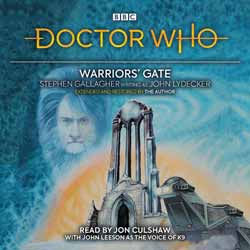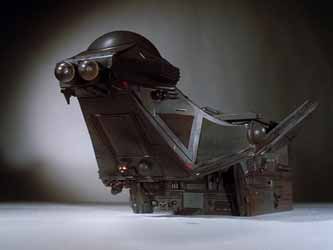|
Click here to return to the main site. Audio Book Review
The Doctor and his companions are trapped in E-Space, struggling to find their way back into their own universe. Arriving at an intersection, the TARDIS is invaded by a refugee of the enslaved Tharil race. With K9 damaged by the Time Winds, the Doctor, Romana and Adric explore the strange white eternity of the Gateway, where past, present and future cross over. They also meet the crew of the Privateer, led by the embattled Rorvik. As all parties strive to find a way out, the Doctor realises that Rorvik’s ship holds the terrible secret of the Tharils’ history, as well as the means of their liberation… This is a very special presentation of Stephen Gallagher’s 1982 novelisation (writing under the pen name of John Lydecker) of his own scripts for the 1981 Fourth Doctor serial Warriors’ Gate, the final part of the E-Space trilogy. Not only is it read by Jon Culshaw, who is well known for his impersonation of Tom Baker, but it also features John Leeson as the voice of K9. What is most exciting, though, is the fact that this edition has been extended and restored by Gallagher himself from his original manuscript. As the author explains in his liner note (which takes the place of the usual behind-the-scenes information from David J Howe), his initial version included numerous scenes and ideas that had been altered or discarded during the making of the television serial. When this approach was vetoed by the Doctor Who production office, Gallagher was forced to re-edit and restructure his text in order to make it more closely resemble the transmitted story. The physical process of performing and, 37 years later, reversing those changes makes for fascinating reading in its own right – a painstaking operation involving much Tippexing out, photocopying, colour coding, and holding pages up to the light to see what had once been written under the pasted-on corrections. Judging by the running time of the audio book (4 hours 40 minutes), I would say that the resulting narrative has been expanded by at least 25%. Not so expertly extended is the Privateer on the front cover. Clearly the designer tasked with making Andrew Skilleter’s cover illustration (one of his finest, in my opinion) fit the square format of a CD jewel case did not know what the back end of the slavers’ ship looked like, and so cloned parts of the front of the vessel. Admittedly, reference photographs of the model are hard to come by, but for the record, this is how the Privateer looks in a screen capture from Part Two of the serial (see pic).
I do recall that when I first read the book, as a 13-year-old in 1983, I found it incredibly difficult to get into. I probably wasn’t mature enough to appreciate the intricacies of Gallagher / Lydecker’s prose, having no idea what “sharp-edged wadis” or “wide alluvial fans” were. The unfamiliar prologue didn’t help. Neither did the lack of chapter divisions – the novelisation comprises a single, continuous block of text. I persuaded my mum to assist by reading out the opening pages to me. Now, of course, we have Jon Culshaw, who kindly reads out the whole thing! The book became easier for the teenage me once the TARDIS crew entered the proceedings – this happens during Track 8 (of 92) of the audio book. For some reason, one sentence that has always stuck in my memory occurs when, having just had his space-time craft commandeered by the Tharil Biroc, the Doctor tells his companions, “‘That was Biroc,’ … somewhat unnecessarily.” I was pleased to hear this line being spoken by Culshaw. What is definitely made clearer in prose than it was on screen is how the Tharils navigate through alternate timelines, selecting one future from countless possibilities, a process we experience from Biroc’s point of view. What is also readily apparent is that the characters’ movements take some very different turns in this expanded audiobook than they did in any previously released version of this story. For example, the Doctor meets the Privateer crew before exploring the Gateway, rather than vice versa. This is not the whimsical Fourth Doctor that we are used to hearing from Culshaw, but the more subdued version from Season 18. The reader also distinguishes the other characters well, including Captain Rorvik and his unruly rabble of a crew, who are as delightfully disorganised here as they ever were. Being a talented impressionist and a Doctor Who fan to boot, Culshaw is particularly good at capturing the voices of Clifford Rose, Kenneth Cope and David Kincaid, who played the aggressive Rorvik, the world-weary Packard and the oafish Lane on television. I dare say he would have done a decent K9, too, had John Leeson not been available. Like Tharils traversing the timelines, Gallagher, Culshaw and Leeson have opened up a new possibility. The audio book of Warriors’ Gate provides the most detailed telling to date of one of the classic show’s most challenging narratives. 9 Richard McGinlay Buy this item online
|
|---|

 To be honest, I don’t remember the printed version of the novelisation well enough to identify each and every element that has been newly restored. Even in its published form, the book contained many deviations from the broadcast adventure, including much of the dialogue, an opening sequence that explains how Rorvik’s ship ended up in the white void, and a less rushed and more poignant farewell for Romana and K9.
To be honest, I don’t remember the printed version of the novelisation well enough to identify each and every element that has been newly restored. Even in its published form, the book contained many deviations from the broadcast adventure, including much of the dialogue, an opening sequence that explains how Rorvik’s ship ended up in the white void, and a less rushed and more poignant farewell for Romana and K9.